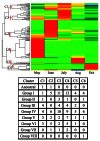Towards uncovering the roles of switchgrass peroxidases in plant processes
- PMID: 23802005
- PMCID: PMC3686051
- DOI: 10.3389/fpls.2013.00202
Towards uncovering the roles of switchgrass peroxidases in plant processes
Abstract
Herbaceous perennial plants selected as potential biofuel feedstocks had been understudied at the genomic and functional genomic levels. Recent investments, primarily by the U.S. Department of Energy, have led to the development of a number of molecular resources for bioenergy grasses, such as the partially annotated genome for switchgrass (Panicum virgatum L.), and some related diploid species. In its current version, the switchgrass genome contains 65,878 gene models arising from the A and B genomes of this tetraploid grass. The availability of these gene sequences provides a framework to exploit transcriptomic data obtained from next-generation sequencing platforms to address questions of biological importance. One such question pertains to discovery of genes and proteins important for biotic and abiotic stress responses, and how these components might affect biomass quality and stress response in plants engineered for a specific end purpose. It can be expected that production of switchgrass on marginal lands will expose plants to diverse stresses, including herbivory by insects. Class III plant peroxidases have been implicated in many developmental responses such as lignification and in the adaptive responses of plants to insect feeding. Here, we have analyzed the class III peroxidases encoded by the switchgrass genome, and have mined available transcriptomic datasets to develop a first understanding of the expression profiles of the class III peroxidases in different plant tissues. Lastly, we have identified switchgrass peroxidases that appear to be orthologs of enzymes shown to play key roles in lignification and plant defense responses to hemipterans.
Keywords: Hemiptera; ROS; biotic stress; lignin; peroxidases; switchgrass.
Figures




Similar articles
-
Soil Origin and Plant Genotype Modulate Switchgrass Aboveground Productivity and Root Microbiome Assembly.mBio. 2022 Apr 26;13(2):e0007922. doi: 10.1128/mbio.00079-22. Epub 2022 Apr 6. mBio. 2022. PMID: 35384699 Free PMC article.
-
Comprehensive analysis of CCCH-type zinc finger family genes facilitates functional gene discovery and reflects recent allopolyploidization event in tetraploid switchgrass.BMC Genomics. 2015 Feb 25;16(1):129. doi: 10.1186/s12864-015-1328-4. BMC Genomics. 2015. PMID: 25765300 Free PMC article.
-
Transcriptome analysis of heat stress response in switchgrass (Panicum virgatum L.).BMC Plant Biol. 2013 Oct 6;13:153. doi: 10.1186/1471-2229-13-153. BMC Plant Biol. 2013. PMID: 24093800 Free PMC article.
-
Senescence, dormancy and tillering in perennial C4 grasses.Plant Sci. 2014 Mar;217-218:140-51. doi: 10.1016/j.plantsci.2013.12.012. Epub 2013 Dec 30. Plant Sci. 2014. PMID: 24467906 Review.
-
Class III peroxidase: an indispensable enzyme for biotic/abiotic stress tolerance and a potent candidate for crop improvement.Plant Cell Rep. 2020 Nov;39(11):1381-1393. doi: 10.1007/s00299-020-02588-y. Epub 2020 Sep 4. Plant Cell Rep. 2020. PMID: 32886139 Review.
Cited by
-
Contrasting metabolism in perenniating structures of upland and lowland switchgrass plants late in the growing season.PLoS One. 2014 Aug 18;9(8):e105138. doi: 10.1371/journal.pone.0105138. eCollection 2014. PLoS One. 2014. PMID: 25133804 Free PMC article.
-
Transcriptional analysis of defense mechanisms in upland tetraploid switchgrass to greenbugs.BMC Plant Biol. 2017 Feb 16;17(1):46. doi: 10.1186/s12870-017-0998-2. BMC Plant Biol. 2017. PMID: 28209137 Free PMC article.
-
Activity of Cytosolic Ascorbate Peroxidase (APX) from Panicum virgatum against Ascorbate and Phenylpropanoids.Int J Mol Sci. 2023 Jan 16;24(2):1778. doi: 10.3390/ijms24021778. Int J Mol Sci. 2023. PMID: 36675291 Free PMC article.
-
Combining -Omics to Unravel the Impact of Copper Nutrition on Alfalfa (Medicago sativa) Stem Metabolism.Plant Cell Physiol. 2016 Feb;57(2):407-22. doi: 10.1093/pcp/pcw001. Epub 2016 Feb 9. Plant Cell Physiol. 2016. PMID: 26865661 Free PMC article.
-
Characterization of Class III Peroxidases from Switchgrass.Plant Physiol. 2017 Jan;173(1):417-433. doi: 10.1104/pp.16.01426. Epub 2016 Nov 15. Plant Physiol. 2017. PMID: 27879392 Free PMC article.
References
-
- Adamski D., Johnson P., Boe A., Bradshaw J., Pultyniewicz A. (2010). Descriptions of life-stages of Blastobasis repartella (Lepidoptera: Gelechioidea: Coleophoridae: Blastobasinae) and observations on its biology in switchgrass. Zootaxa 41–54
-
- Altschul S. F., Gish W., Miller W., Myers E. W., Lipman D. J. (1990). Basic local alignment search tool. J. Mol. Biol. 215 403–410 - PubMed
LinkOut - more resources
Full Text Sources
Other Literature Sources

